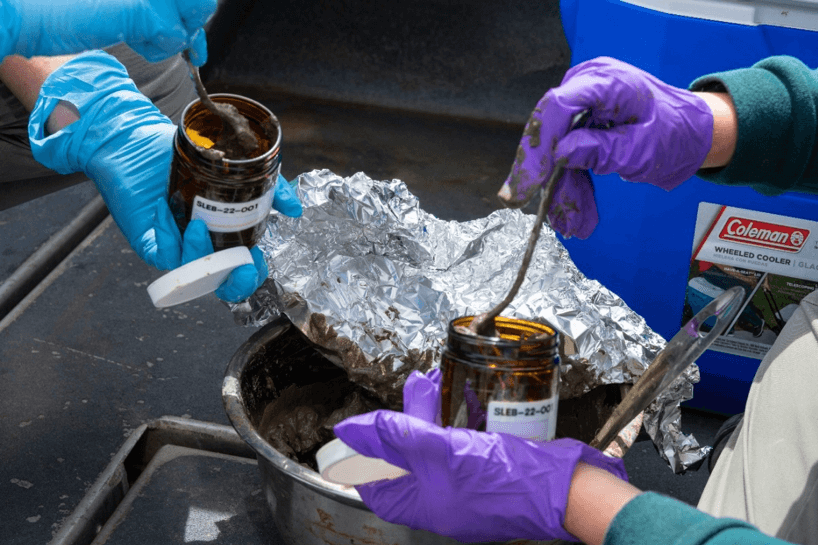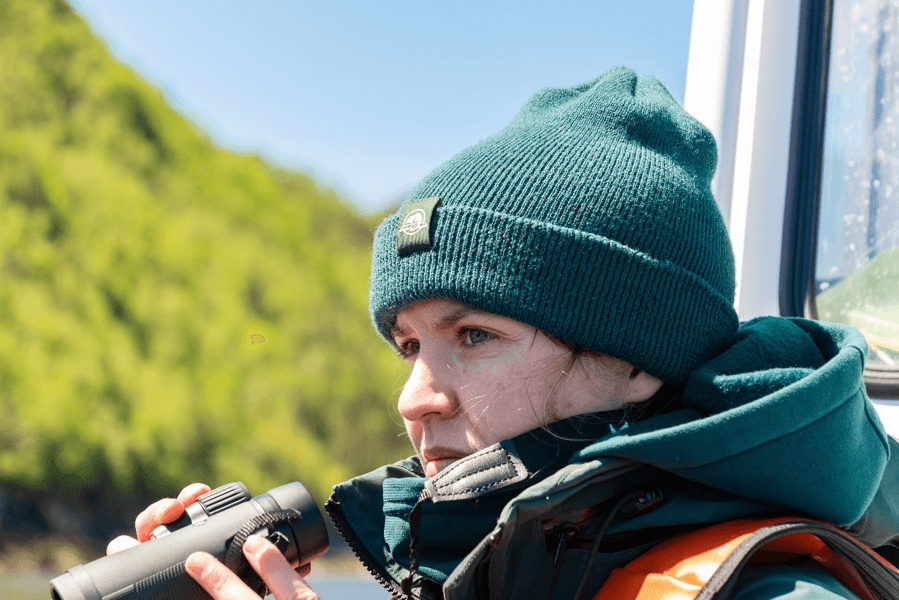By Eliza-Jane Morin, Resource Management Officer, Parks Canada
During the summer months, the Parks Canada conservation team in the Saguenay-St. Lawrence Marine Park is busy carrying out field work, both for our ecological sustainability monitoring program and for research projects with various collaborators.
The morning of August 28 begins like any other. I arrive at the office around 8:00 a.m. and take a glance at the operational schedule for the day. I see that my colleague Pierre-Alexandre and I have been tasked with sampling sediment in the Upper Estuary. I’m instantly excited, as this is one of my favourite projects! This research project is carried out in collaboration with Dr. Tanya Brown, research scientist at Fisheries and Oceans Canada and Dr. Antoine Simond, postdoctoral research scientist at Simon Fraser University. The main objective of this project is to characterize sediment contaminants in the critical habitat of the St. Lawrence Estuary beluga, an endangered species.
Belugas have a varied diet, including groundfish such as cod and hake, as well as invertebrates such as gastropods and polychaetes (bristle worms). When feeding, belugas suck up water and the prey it contains near the seabed. This feeding method can expose belugas to contaminants that accumulate in the upper layer of sediment. One example of a contaminant that has previously caused significant adverse consequences for belugas are polyhydroxyalkanoates (PHAs). Exposure to high levels of PHAs, a byproduct of aluminum smelters, has been linked to the widespread occurrences of cancer observed in belugas in the 1960s and 70s. Although exposure to PHAs has declined significantly ever since the Government of Quebec prohibited aluminum smelters from discharging their waste into the Saguenay River, other emerging contaminants might be adversely affecting the beluga’s recovery. For this reason, it is important to continually monitor and characterize the contaminants in this species’ habitat.
Before leaving, I check the weather forecast for the day to confirm that the winds are not too strong for sampling. Environment and Climate Change Canada forecasts overcast weather, with a west wind of 5 knots (9 km/h), i.e. perfect conditions for carrying out this type of work. Once our field gear is ready and loaded into the truck, we drive to the marina to meet up with Simon, the captain of our research vessel L’Alliance, who is running through the final safety checks before we head out to sea.
he sampling site is near the archipelago known as Les Pèlerins, which lies upstream of Rivière-du-Loup. About an hour and a half after leaving the Tadoussac marina, we reach our destination. The water is calm and the outlines of the numerous islands dotting the Upper Estuary can be seen in the distance. While I begin to fill out the technical sheet with the weather conditions, the exact coordinates of the sample and the water depth, Pierre-Alexandre prepares the Ponar grab sampler (also known simply as a “grab”) at the stern of the boat. A Ponar grab is a type of benthic sampler used to collect surface sediment samples.
Once the grab is attached to our winch, we begin to lower it into the water behind the boat. The total depth at this location is approximately 65 metres. We continue to deploy the grab until it hits the seabed. The tricky part of this sampling protocol is that the current in the estuary can be very strong, making direct impact on the seabed difficult. For the grab to take its sample, any tension in the rope that lowers the sampler must be released so that the sampling mechanism can be triggered. We approach 65 metres and suddenly the winch rope slackens and I know that we’ve hit bottom. I wait about 10 seconds before starting to reel the grab back up to the surface.
There is always a moment of anticipation before the grab rises to the surface. You never know what to expect. Did the mechanisms trigger correctly? Will there be sediment in the grab or just water and rocks? I carefully observe the water surface as I reel up the grab sampler using the winch. Suddenly, I see the metallic glimmer of the device; it seems to have closed correctly! I continue to raise the grab so that Pierre-Alexandre can guide it onto the rear deck of the boat. We gently open the grab to check the sediment inside. To our surprise, we see anemones that were captured together with the sediment sample!
hat I like most about this sampling method is that we never know what kinds of surprises will be hiding in our sediment samples. To date we’ve caught a sea cucumber, scallops, crabs, starfish, sand lance and a sculpin! We love discovering the many wonders of the St. Lawrence Estuary. After carefully removing the anemones and releasing them back into the water, we collect the sediment. We repeat this process a few times until we have enough sediment to fill our jars. We were less fortunate on the second drop, as the grab did not close correctly due to the presence of a large rock and no sediment was recovered. We give it another go. Simon stabilizes the boat and we drop the grab back to the sea floor. On the third and fourth attempts, we managed to collect enough sediment to fill our nine sample jars. The latter will be frozen at -20°C and shipped to British Columbia, where they will be analyzed for PHAs, PCBs, heavy metals and microplastics, amongst other things.
After a long but rewarding day of field work, we slowly make our way back to Tadoussac, where we will wash our equipment and store our samples in our lab. Another day of sampling is complete… On to the next project!
Autrice : Eliza-Jane Morin, Resource Management Officer
Eliza holds a bachelor’s degree in marine biology from Dalhousie University in Halifax and a master’s degree in natural resource management from Iceland’s Akureyri University with an emphasis in coastal and marine resources. Her master’s research focused on the impacts of eider down harvesting practices on arctic terns in Iceland. She has 6 years of experience in the field of conservation, especially in the sub-disciplines of ornithology and marine conservation. Her work has taken her from the Peruvian Amazon to the Northeast Atlantic in Iceland, not to mention western Canada and Ontario. She joined the Parks Canada conservation team at the Saguenay-St. Lawrence Marine Park in June 2021. She notably participates in the characterization of contaminants in beluga habitat, harbour seal monitoring in the Saguenay Fjord, and winter Barrow’s goldeneye monitoring in the St. Lawrence estuary.












